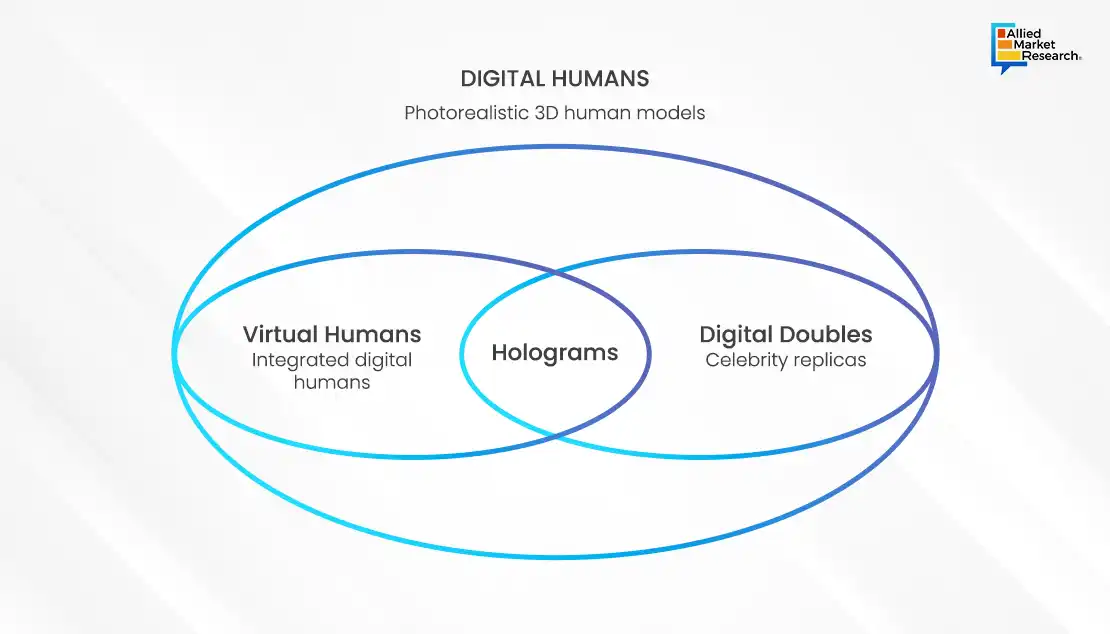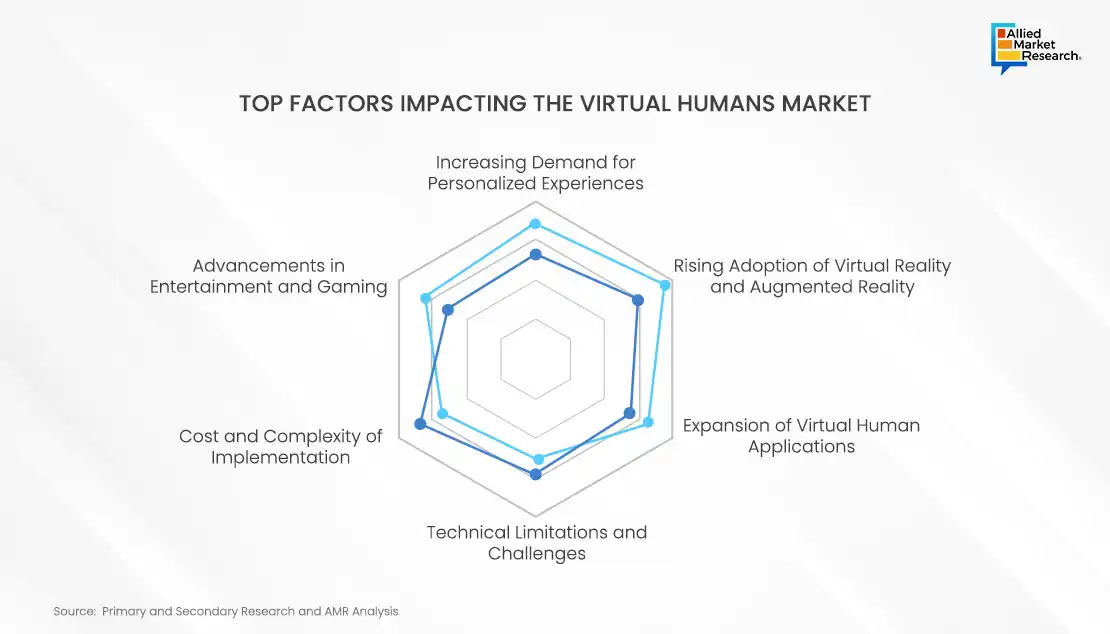Table Of Contents
- Virtual Human Market in the Last Decade
- Innovative Virtual Human Solutions: Embracing Future Trends
- Emotional Intelligence
- Conversational Agents
- Virtual Reality Interfaces
- The Future of Virtual Humans: Opportunities and Challenges
- Opportunities in a Dynamic Landscape
- Challenges on the Road Ahead
- Navigating the Future Landscape
- Future Trends in the Virtual Human Market: Anticipated Transformations
- Conclusion

Onkar Sumant

Pooja Parvatkar
Virtual Human Market: A Booming Sector Set for Evolution

The virtual human market is rapidly expanding, owing to the convergence of advanced artificial intelligence, virtual reality, and human-computer interaction technologies. This has fueled remarkable innovations including virtual assistants, customer service bots, digital avatars, and even virtual influencers. Spearheading this groundbreaking work are industry leaders such as Soul Machines, Digital Domain, and Daz 3D, boldly pushing the boundaries and driving the evolution of virtual human technology. With ongoing advancements and growth, this market holds great potential for new trends, opportunities, and developments across a diverse range of industries.
Moreover, the incorporation of virtual human technology into the metaverse is set to transform the landscape of digital communication. By creating a universal virtual world, the metaverse enables individuals to engage with one another and digital landscapes in real-time. Virtual humans will play a pivotal role in shaping the metaverse encounter, serving as personalized avatars for users and elevating social connections through their lifelike demeanor. As the metaverse continues to gain momentum, the demand for virtual human technology is predicted to surge, driving continued growth in the market for virtual humans.
Virtual Human Market in the Last Decade
Over the past decade, the virtual human market has seen a remarkable surge, driven by the convergence of AI, computer graphics, and natural language processing. This dynamic combination has propelled the global virtual human market from $4 billion in 2018 to a significant value of $440.3 billion by 2031, fueled by the growing demand for immersive and engaging digital experiences. While virtual humans were once limited to specialized domains such as gaming and animation, their reach has substantially widened to include diverse fields such as healthcare, where virtual therapists and patient companions are revolutionizing the way personalized care and support is provided to individuals.
Furthermore, this technology has found its way into educational environments, acting as interactive tutors and learning companions for people of all ages. Its flexibility and compatibility to work within various sectors make it an invaluable asset in various industries, including entertainment, marketing, customer service, and others. With the potential to enhance engagement and productivity, both businesses and consumers are anticipating further expansion and diversification of virtual human technology in the coming years.

Innovative Virtual Human Solutions: Embracing Future Trends
The virtual human market is in a constant state of evolution, with companies continually pouring resources into cutting-edge technologies to elevate the levels of realism, interactivity, and emotional intelligence. Industry leaders are relentlessly pushing the limits of virtual human technology, delving into uncharted territories such as emotional artificial intelligence, conversational agents, and virtual reality interfaces. These groundbreaking advancements open limitless possibilities, from virtual shopping aides to adaptable virtual tutors tailored to individual modes of learning. For instance, on February 21, 2024, a research team led by Professor Ming Zhu from the University of California, Berkeley, and Professor Lei Li from the National University of Singapore has developed a new computing method called Simultaneous and Heterogeneous Multithreading (SHMT) that can double the processing speed of existing hardware, paving the way for more realistic and interactive virtual humans.
Emotional Intelligence
The virtual human market is undergoing a major shift, with emotional intelligence being a key factor in the development of digital avatars and virtual assistants. Leading the way is Soul Machines, a groundbreaking company that is revolutionizing the concept of virtual humans. On October 27, 2023, TechCrunch announced that Soul Machines raised an impressive $72.0 million to advance their cutting-edge technology, which includes emotionally responsive AI avatars. These avatars can recognize and react to emotions in real-time, opening endless possibilities such as personalized therapy sessions with a virtual therapist who can empathize with emotions, or customer service agents who can skillfully address complex issues with genuine compassion. This funding will fuel Soul Machines' continued development and potential applications in areas such as mental health, education, and entertainment.
Conversational Agents
The rapidly growing virtual human market welcomed conversational agents, also known as chatbots. These highly intelligent virtual assistants are adept at engaging users in natural, human-like conversations, offering a wealth of information, support, and tailored suggestions. Cutting-edge firms such as Digital Domain are harnessing the power of advanced natural language processing methods to craft these impressive conversational agents. For instance, on November 29, 2023, Replika, an AI companion designed to provide personalized emotional support through conversation, announced securing $30 million in funding. This funding, as reported by TechCrunch, aims to fuel Replika's expansion by enhancing its AI capabilities and attracting a wider user base.
Replika offers users the ability to engage in personalized conversations that cater to their individual needs and preferences. This funding could potentially lead to advancements in Replika's ability to understand and respond to users' emotions, feelings, and experiences in a more meaningful and supportive way.

However, some experts raise concerns about the potential limitations of AI companions in providing genuine emotional support. They emphasize the importance of further research to determine the effectiveness of such technology in addressing complex human emotions and the potential risks of overdependence on AI for emotional needs.
Virtual Reality Interfaces
The emergence of virtual reality (VR) interfaces has completely transformed the way users interact with virtual beings. By providing truly immersive experiences, the companies have effectively bridged the gap between the real and virtual worlds. Leading enterprises such as Daz 3D are leading the charge by producing advanced VR platforms that allow individuals to design, personalize, and seamlessly engage with highly realistic digital avatars within virtual spaces. With endless possibilities, these VR interfaces have proven to be invaluable in various industries such as gaming, education, and even social encounters. For instance, on December 6, 2023 - Tailspin, a company pioneering immersive virtual reality (VR) learning experiences, received $15 million in funding, as reported by TechCrunch. This funding aims to expand their content library and develop new VR experiences, potentially transforming the educational landscape.
Talespin's VR platforms aim to revolutionize education by creating engaging and interactive learning environments. This approach leverages the power of VR to simulate real-world scenarios and complex concepts, potentially leading to improved student engagement and learning outcomes. Imagine language learning sessions with virtual tutors in realistic environments or medical students practicing procedures on virtual patients. The possibilities for learning and training using VR and virtual humans are vast.
The Future of Virtual Humans: Opportunities and Challenges
Amidst the rapid evolution of technology, the virtual human market is poised for exceptional expansion and advancement. This is driven by the growing desire for immersive and interactive digital experiences. However, as with any growth opportunity, there are also significant challenges to consider. These include ethical implications, technical boundaries, and privacy issues surrounding the gathering and utilization of data. Moreover, the future for virtual humans looks promising, providing companies with a platform to pave the way for novel applications and transform the way users interact with technology.
Opportunities in a Dynamic Landscape
The virtual human market presents a vast opportunity for companies that are bold enough to navigate its intricacies and capitalize on emerging trends. As the digital world rapidly evolves, there is a growing demand for immersive experiences that blur the line between the physical and the virtual. By offering virtual humans as a gateway to these experiences, businesses can connect with their audience more substantially and engagingly. Whether as virtual customer service representatives or artificial intelligence-powered companions, the potential for innovation and differentiation knows no bounds in this market.

The inclusion of virtual humans in diverse fields such as healthcare, education, and entertainment offers exciting opportunities for progress and development. In the healthcare industry, personalized virtual therapists and patient companions offer valuable support and direction, enhancing conventional forms of treatment and ultimately improving patient results. In education, virtual tutors heighten learning journeys by providing personalized guidance and feedback, catering to unique learning styles and preferences. Similarly, in the entertainment sector, virtual influencers, and digital avatars amaze viewers with their realistic appearances and captivating personalities, leading to increased brand engagement and long-term loyalty.
Challenges on the Road Ahead
While virtual humans hold immense potential, the path to fully utilizing their skills is filled with challenges. The ethical implications of using these artificial beings raise serious questions about privacy, consent, and digital liberty. It is critical that users properly explore and answer these challenges before creating and introducing virtual humans in society. By prioritizing users' well-being and autonomy, users may develop confidence and drive wider adoption of this technology among consumers.
Conquering technological boundaries is not an easy task, especially when it comes to creating virtual humans with superior natural language processing, emotional intelligence, and lifelike animation abilities. To achieve these objectives, complex AI algorithms and advanced emotional modeling approaches must be used, all while maintaining real-time interactions with human emotions. To overcome these obstacles will surely need considerable investment in research and development, as well as a strong collaboration between many areas and sectors.
Moreover, the rising issue of privacy regarding the collection and use of data presents a new set of challenges, particularly considering strict regulations such as the General Data Protection Regulation (GDPR) and the California Consumer Privacy Act (CCPA). Finding a balance between the need for data-driven insights and the crucial protection of user privacy is a complex task, necessitating robust data governance frameworks and transparent communication strategies within industries.
Navigating the Future Landscape
Despite the obstacles that may arise, the potential of virtual humans presents a bright outlook for companies that embrace innovation, collaboration, and adaptability. By conscientiously addressing ethical concerns, surpassing technical barriers, and placing a premium on user confidentiality, businesses can open doors to further advancement and differentiation in the virtual human market. As technology continues to progress, virtual humans will play a pivotal role in shaping the way users interact with technology and one another. This opens endless possibilities for growth and transformation.
Future Trends in the Virtual Human Market: Anticipated Transformations
The future of the virtual human market is expected to witness a paradigm shift, characterized by transformative trends poised to reshape the industry landscape:
- Enhanced Emotional Intelligence: As technology advances, there is increasing focus on equipping virtual beings with enhanced emotional intelligence. This exciting prospect holds the potential for virtual entities to seamlessly comprehend and react to human emotions; thereby forming deeper connections and facilitating more genuine interactions.
- Augmented Reality Integration: The incorporation of augmented reality (AR) is gaining traction, opening new possibilities for immersive encounters with virtual beings. Through AR-powered applications, users will be able to engage with virtual entities in their real-life surroundings, blurring the lines between the physical and digital worlds.
- Hyper-Personalization: In the world of virtual humans, hyper-personalization is set to become a major focal point, thanks to remarkable advancements in AI and data analysis. Powered by these cutting-edge technologies, future virtual beings will possess the unique ability to dynamically adjust their behavior, appearance, and conversation to fit the specific preferences and contexts of individual users. This will result in tailored experiences that deeply resonate with everyone on a personal level.
- Cross-Platform Compatibility: As technology continues to evolve and diversify, virtual humans will become increasingly versatile and adaptable, breaking free from hardware and software constraints. This means that the development of cross-platform compatibility will be a top priority in the coming years. As a result, virtual humans will be able to effortlessly transition between different devices, operating systems, and communication channels, while still delivering an unparalleled user experience.
- Ethical and Diversity Considerations: The upcoming wave of virtual human design and deployment will place a strong emphasis on ethical and diverse considerations. Stakeholders will prioritize inclusivity, fairness, and representation, guaranteeing that virtual entities accurately reflect a diverse range of identities, cultures, and perspectives. This will promote empathy, understanding, and inclusivity in virtual interactions.
- Security and Trustworthiness: As virtual humans become increasingly integrated into users daily lives, ensuring their security and trustworthiness will become more crucial than ever. Advancements in technology will focus on implementing robust security measures, thorough authentication protocols, and transparent mechanisms to safeguard user data, privacy, and trust in virtual interactions.
These transformative trends are poised to revolutionize the virtual human market, ushering in a new era of immersive, personalized, and ethically driven digital experiences that redefine human-computer interaction in profound ways.
Conclusion
The potential of VR interfaces is boundless, as constant advancements are set to revolutionize the way humans interact with computers. Realistic qualities, diverse applications, and customizable experiences are just a few of the factors propelling the growth of VR technology. Leading the charge is industry pioneer Daz 3D, pushing the boundaries of immersive storytelling, social engagement, and teamwork in virtual worlds. As the demand for virtual humans increases, the market is primed for boundless innovation and expansion, offering users an unparalleled level of immersion and presence in the virtual realm. This is where AMR can help businesses seize opportunities and monetize them to the best of their ability.

